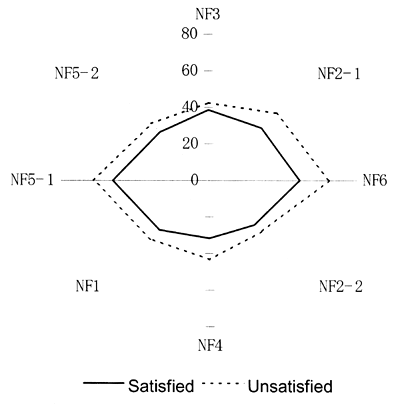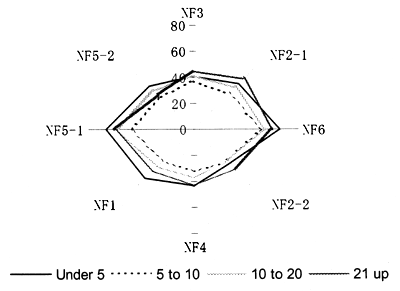Seca GANDASECA, Graduate School of Informatics, Kyoto University, JAPAN H. Hulusi ACAR, Faculty of Forestry, Karadeniz Technical University, Trabzon, TURKEY Tetsuhiko YOSHIMURA, Graduate School of Informatics, Kyoto University, JAPAN
Abstract
The objective of this study is to clarify health and safety conditions of forestry workers and identify the factors affecting job satisfaction and fatigue symptoms. The research was conducted in northeast Turkey in June 1998 using questionnaires, and we collected 113 responses. In this research, the questionnaires were distributed to cable harvesting workers at harvesting sites. The results showed that many of the forestry workers had low back pain and that attention should be paid to muscular exertion, especially while lifting heavy objects such as chainsaws or logs.
Several accidents and near-miss incidents happened while driving and engaging in forestry work. Many workers wanted more salary and insurance because their salary was not high, although their work was hard and dangerous. In addition, about 73 percent of the workers did not wear safety equipment such as helmets and gloves. Actually, real accidents were not frequent but 31 percent of the workers had experienced near-miss incidents.
According to the analysis of potential factors affecting job satisfaction, unmarried and well-educated workers, chainsaw operators, manual workers and relatively new workers were dissatisfied. In addition, the fatigue symptoms were higher for the dissatisfied, unmarried, older and longer period workers and those engaged in chainsaw and manual labour. To enhance the satisfaction levels of forestry workers, their working and living conditions, and in particular, their salaries, should be improved, along with public facilities and amusements, in order to reduce fatigue symptoms. This study identified many problems to be solved in order to improve forestry workers' health and safety conditions and promote their welfare.
Introduction
It is known that the working and living conditions of forestry workers are unfavourable because their work is heavy, dirty and dangerous with poor working postures and exposure to noise and vibrations. Moreover, workers often live in conditions with poor infrastructure and hygiene compared with people living in cities. In Turkey, about 26.7 percent of the total area is covered with forests and managed by the Ministry of Forestry (Muthoo, 1997). The annual production of sawnwood is 4 928 000 m3 and that of fuelwood is 9 796 000 m3 (Muthoo, 1997). Many people earn a significant portion of their earnings from employment in harvesting, transport, processing nurseries and reforestation. All forests are owned by the State forest enterprise and all forestry workers are employed by it. Major species for production are Picea orientalis, Fagus orientalis and Abies nordmanniana.
Nowadays, more attention is being paid to the safety and health conditions of forestry workers, which are taken into consideration in the code of practice for sustainable forest management. Apud (1995) mentioned the importance of research on safety and health in forestry work as follows: It is increasingly understood that sustainable forest management is not possible without sustainable use and development of human resources, especially of forestry workers, who are often the de facto managers of forest resources. There is also the code of practice on safety and health in forestry work (ILO, 1997), whose objectives are to protect workers through occupational safety procedures and elimination of health hazards and to prevent or reduce the incidence of illness or injury caused by them. In Turkey, in fact, there is still lack of statistical data on forestry worker health and safety.
The objective of this study is to clarify health and safety conditions and identify the factors affecting job satisfaction and fatigue symptoms; also how to improve such conditions. In this study, we asked forestry workers about job satisfaction and, in the event it was negative, the reasons for dissatisfaction.
With respect to forestry workers' life and health, we also asked about lower back pain, sore or stiff shoulders and their frequency. Furthermore, in order to determine safety conditions, questions included: experience with accidents, situations when accidents happened, frequency of experiencing near-miss incidents and personal protective equipment (PPE) used. Finally, we asked workers to identify what was needed to improve the situation and to clarify the existence of fatigue symptoms.
Methods
We conducted the research in the Artvin region, in northeast Turkey, in June 1998, using questionnaires. The questionnaire on forestry worker health and safety was distributed both in offices of the forestry agency and at harvesting sites, and we collected 113 responses by interview.
Table 1 shows personal data. Following the questions on personal data, there were others on frequency of low back pain and sore or stiff shoulders. Concerning issues of safety, questions were on the involvement in occupational accidents, situations when such accidents occurred, frequency of near-miss incidents and the use of PPE. The next question was about items necessary, or which required improvement, to make living conditions better. Finally, there were questions on job satisfaction and salary. In addition, the workers also answered 81 questions regarding fatigue symptoms. Potential factors affecting job satisfaction with forestry work were analysed using the Quantification Method II. Five factors - marital status, age, educational background, period of work and type of work - were used for the analysis. In this analysis, any blank answers to questions on job satisfaction or any of the above six factors were excluded. As a result, 111 examples were used.
Results and discussion
Personal data on the respondents
Table 1 shows personal data on the 113 respondents. As shown in the table, all were male and mostly over the age of 30 years. Most of them had graduated from elementary school and junior high school, and most are machine and chainsaw operators. The remaining respondents are supervisors, manual workers and office workers who were included in this study because they are part of the workforce living under unfavourable conditions, together with other workers, and who might be stressed physically or mentally.
Health conditions
Low back pain is one of the most common and most costly work-related musculoskeletal disorders. Occupational risk factors for low back injuries include manual handling tasks, twisting, bending, falling, reaching, lifting excessive weights, prolonged sitting and vibration (Ness, 1996). As shown in Table 2, 60 respondents (53 percent) suffered low back pain. With regard to the frequency of low back pain (see Table 3), most respondents answered that it occurred occasionally.
Pain in the shoulder region is second only to low back injury and neck pain in clinical frequency, and the reporting of such problems is on the rise (Salvendy, 1997). Table 2 shows that 35 respondents (31 percent) experienced sore or stiff shoulders, which was fewer than those who had low back pain. However, careful attention must be paid to avoid shoulder damage because the shoulder is one of the most complex structures of the body, with numerous muscles and ligaments crossing the shoulder joint complex (Salvendy, 1997). Regarding the frequency of sore or stiff shoulders (see Table 3), a large number of respondents (23) occasionally experienced these symptoms.
Safety conditions
Forestry workers are generally exposed to high-risk situations while working in the forest. Although it cannot be denied that workers' negligence or thoughtlessness plays a decisive role in the cause of occupational accidents, risk factors in forestry work should be analysed, identified and removed to prevent occupational accidents or incidents caused or triggered by their work environment or methods. Table 4 shows that one-fifth of the forestry workers experienced occupational accidents. There are 24 percent respondents who have experience with accidents.
The types of accidents related to forestry work are shown in Table 5. Chainsaw cuts to the leg or cut wood hitting the head, shoulder or hand were the most frequent causes of accidents. To reduce such accidents, protective equipment and training is necessary. The second most frequent accident involved a felled tree or a branch hitting a worker. Accidents of this kind are known to be very typical in the forestry sector. These accidents resulted in bodily injury while the worker was using a chainsaw, and PPE is essential to avoid fatal injuries. In addition, proper training and education might be an effective way to reduce the incidence of these accidents.
Table 6 shows how often the respondents experienced near-miss incidents during the previous year. A near-miss incident means that workers nearly caused or were nearly involved in occupational accidents accompanied by damage, injury or even death. Such incidents are said to include potential risk factors for actual accidents, and the analysis of these incidents is significant in identifying such risk factors so as to take necessary measures before accidents actually happen. Seventy-two percent of the respondents answered that they had not experienced a near-miss incident during the past year, perhaps because many forestry workers forgot such incidents because they had not resulted in injury. Therefore, we suggest that reports on near-miss incidents, as well as actual accidents, should be made daily because it is difficult to remember exactly what happened after a day or two.
As described above, PPE plays an important role in the reduction of fatal injury. The analysis of accident records from logging proved that the introduction of the compulsory use of appropriate PPE and safety devices on chainsaws resulted in a large decrease in certain types of injuries and accidents (FAO, 1992). According to the ILO code of practice (ILO, 1997), workers should be provided with PPE, such as safety boots, clothing that fits the arms and legs closely, safety trousers, gloves, safety helmets, goggles/visor and earmuffs. However, the information given in Table 8 reveals that many workers (73 percent of respondents) did not even wear a helmet, gloves or safety boots. This may be because of a shortage of such equipment or because the PPE was not comfortable to wear for work. Therefore, more PPE should be provided by the management and improvements made so that it is more comfortable to wear.
Living conditions
Table 9 shows what is needed or needs improvement according to responses to the questionnaire. Most respondents expressed the need for a higher salary and occupational insurance, and not a few wanted improvements in the machines they use. They also showed awareness of sustainable forestry, saying that not so many trees should be cut in the forest. In addition, many respondents thought that more attention should be paid to nurseries. Other workers want full-time working in their job. Regarding safety, only one respondent was concerned about occupational safety. As shown in Table 8, PPE was not always used, and some of the accidents could have been prevented if forestry companies had provided PPE, as shown in Table 6, and the forestry workers had used it. In this situation, the awareness of workers regarding occupational safety and health needs to be enhanced by the company.
Almost as many respondents as those who mentioned the need for a better salary noted the need for improvement in social conditions and facilities, such as telecommunications. The fatigue symptom replies showed the existence of psychological fatigue, because the lives of these workers in the forest were monotonous or dull. They need facilities for amusement so as to reduce such fatigue symptoms. It should be noted that better forest silviculture, forest fire prevention and forest protection were found to be important matters of concern among the respondents. Moreover, other workers said they needed more rest time and improvements in living conditions. One respondent required good economical conditions and no political trouble.
Factors affecting job satisfaction
Regarding the question of job satisfaction, 60 workers expressed satisfaction with their job while 53 expressed dissatisfaction. Figures 1 to 5 identify potential factors affecting job satisfaction, such as marital status, age, educational background, period of work and type of work. A positive score in a particular category indicates job dissatisfaction, while conversely a negative score indicates satisfaction. The score range indicates the degree of the effect of each factor on job satisfaction.
As shown in Figure 1, unmarried workers were slightly dissatisfied with their jobs. Regarding age level, in Figure 2, workers under the age of 25 were less satisfied with their jobs, while those over the age of 26 years were satisfied. As shown in Figure 3, regarding educational background, those workers who had graduated from junior and senior high school were dissatisfied, while those who had graduated from elementary school were satisfied. This indicates that workers who had achieved a higher educational level want jobs with better working conditions in order to meet their career goals. Figure 4 shows that workers who had worked for more than five years were slightly more satisfied than those who had worked for less than or equal to five years, but over a period of 21 years workers were less satisfied.
The degree of job satisfaction differed according to the type of work. As shown in Figure 5, machine operators were satisfied with their jobs while chainsaw operators and manual workers were dissatisfied. It should be noted that chainsaw operators were dissatisfied because their work is very strenuous and dangerous. From the range of these scores it can be concluded that educational background and the length of time employed in this work have the greatest effect on job dissatisfaction.
Fatigue symptoms
Figures 6 to 10 show the results of the analysis of fatigue symptoms of forestry workers: NF3 is irritability, NF2-1 is general fatigue, NF6 is chronic tiredness, NF2-2 is physical disorders, NF4 is decreased willingness to work, NF1 is decreased vitality, NF5-1 is anxiety, and NF5-2 is feelings of depression. The group on the left side of the figure shows the psychological fatigue conditions of workers; the right side gives the physiological fatigue conditions of workers.
Figures 6 to 10 also show that workers who feel dissatisfied with their job-such as unmarried and older workers who have worked for a longer period of time, and chainsaw operators and manual workers — have higher fatigue symptoms, both physiological and psychological fatigue, than satisfied workers. Regarding these conditions, it can be understood that dissatisfied feelings will influence the morale and motivation of workers and, furthermore, influence physical fatigue during work time.
Conclusions
With respect to safety and health, there are many risk factors surrounding forestry workers, which are difficult to control. For example, we found that many of the forestry workers suffered low back pain. It should be noted that large spinal-disc compression forces can be produced by muscular exertion, especially while lifting, and the results if repeated are believed to increase the risk of disc degeneration and accompany chronic low back symptoms (Chaffin and Anderson, 1991). Therefore, attention should be paid to muscular exertion, especially while lifting heavy objects, such as chainsaws or logs.
With regard to safety, several accidents and near-miss incidents happened during driving and forestry work. To prevent such accidents, it is important to supply forestry workers with more PPE, to establish traffic rules on forest roads and to improve their muddy surface. It is also important to provide forestry workers with training and education in safe driving as well as safe work habits. In conclusion, forestry workers need to be provided with knowledge, experience and resources in order to carry out safe and healthy work; attention must be paid to safety and health at all levels, that is, by workers themselves, as well as by supervisors and management.
Regarding wages, it was found that most forestry workers were dissatisfied with their salaries. The analysis of potential factors affecting job satisfaction showed that unmarried workers and those workers with a higher education, as well as chainsaw operators, manual workers, and relatively new workers were dissatisfied. In addition, fatigue symptoms were higher for the unsatisfied, unmarried, the older and longer period workers, chainsaw and manual workers. To improve their satisfaction levels, their working and living conditions and, in particular, their salaries should be increased. Moreover to improve working conditions, public facilities and amusements are needed to reduce fatigue symptoms of forestry workers.
Figures

Figure 1. Category of marital status (Range: 0.826)

Figure 2. Category of age (Range: 0.383)

Figure 3. Category of education (Range: 2.041)

Figure 4. Category of period of work (Range: 2.493)

Figure 5. Category of kind of work (Range: 0.621)

Figure 6. Cumulative of fatigue symptoms according to job satisfaction

Figure 7. Cumulative of fatigue symptoms according to marital status

Figure 8. Cumulative of fatigue symptoms according to age

Figure 9. Cumulative of fatigue symptoms according to period of work

Figure 10. Cumulative of fatigue symptoms according to type of work
Tables
Table 1. Personal data on respondents
| Item | Category | Number |
|---|---|---|
| Gender | Male | 113 |
| Female | 0 | |
| Marital status | Married | 87 |
| Single | 26 | |
| N/A | 0 | |
| Age | ≤25 | 19 |
| 26–30 | 27 | |
| 31–35 | 24 | |
| 36≤ | 41 | |
| N/A | 2 | |
| Educational background | Elementary school | 62 |
| Junior high school | 20 | |
| High school | 27 | |
| College/University | 2 | |
| Others | 2 | |
| N/A | 0 | |
| Period of employment (years) | ≤1 | 8 |
| 1–5 | 8 | |
| 5–10 | 35 | |
| 10< | 86 | |
| N/A | 11 | |
| Type of work | Supervisor | 3 |
| Machine operator | 45 | |
| Chainsaw operator | 42 | |
| Manual worker | 3 | |
| Other | 19 | |
| N/A | 1 | |
| Kind of Employment | Part time | 100 |
| Full time | 13 |
Table 2. Low back pain and sore or stiff shoulder
| Answer | Low back pain | Sore or stiff shoulder |
|---|---|---|
| Yes | 60 | 35 |
| No | 52 | 77 |
| N/A | 1 | 1 |
Table 3. Frequency of feeling low back pain and sore or stiff shoulder
| Answer | Low back pain | Sore or stiff shoulder |
|---|---|---|
| Daily | 13 | 9 |
| Often | 3 | 3 |
| Occasionally | 41 | 23 |
| N/A | 3 | 0 |
Table 4. Experience with accidents
| Answer | Number |
|---|---|
| Yes | 27 |
| No | 85 |
| N/A | 1 |
Table 5. Accidents related to forestry work.
| Situations | Number |
|---|---|
| Body, forehand, leg cut by chainsaw | 11 |
| Worker hit by felled tree or its branch | 9 |
| Forehand, leg cut by axe | 2 |
| Truck fell out from forest road | 1 |
| Rock fell on his shoes | 1 |
| N/A | 3 |
Table 6. Experience of near-miss incident
| Answer | Number |
|---|---|
| Yes | 31 |
| No | 81 |
| N/A | 1 |
Table 7. Frequency of experiencing near-miss incident
| Answer | Number |
|---|---|
| Very often | 7 |
| Often | 6 |
| Sometimes | 8 |
| Rarely | 8 |
| None | 82 |
| N/A | 2 |
Table 8. Personal protective equipment used
| Personal protective equipment | Number | Percentage |
|---|---|---|
| Helmet | 4 | 3.4 |
| Gloves | 18 | 15.1 |
| Safety boots | 4 | 3.4 |
| Safety jackets | 1 | 0.8 |
| Safety trousers | 0 | 0 |
| Eye protection | 1 | 0.8 |
| Earmuffs | 2 | 1.7 |
| None | 87 | 73.1 |
| N/A | 2 | 1.7 |
Table 9. Items needed or need improvement in (multiple answer)
| Items | Number |
|---|---|
| Salary | 13 |
| Insurance | 13 |
| Should not cut so many trees | 10 |
| Improvement machine | 9 |
| Need good Nursery | 6 |
| Full time working system | 4 |
| Good social condition | 2 |
| Troubles concerning politics | 2 |
| More rest time | 1 |
| Life condition should be improved | 1 |
| Log standard is necessary | 1 |
| Forest insect | 1 |
| Forest fire | 1 |
| Silviculture should be improved | 1 |
| Attention to safety and health | 1 |
| Harvesting plan is necessary | 1 |
| Job must be given to good worker | 1 |
| Powerful helicopter | 1 |
| Others | 1 |
Table 10. Job satisfaction
| Answer | Number |
|---|---|
| Yes | 60 |
| No | 3 |
Table 11. Reasons for dissatisfaction (multiple answer)
| Reasons | Number |
|---|---|
| Salary | 19 |
| Hard work | 10 |
| No full time | 5 |
| Distance to work sites | 2 |
| Others | 7 |
| N/A | 13 |
References
Apud, E. 1995. Ergonomics in forestry: the Chilean case. 162 pp, ILO, Geneva.
Chaffin, D.B. & Anderson, G.B. 1991 Occupational biomechanics, second edition. 518 pp, John Wiley and Sons, New York.
FAO. 1992. Introduction to ergonomics in forestry in developing countries. 200 pp, FAO, Rome.
Gandaseca, S., Yoshimura, T., Yamamoto, T. & Mulyono, S. 1998. A biomechanical analysis of industrial forest plantation workers in East Kalimantan. J. For. Res. 3: 75–79.
ILO 1997. Safety and health in forestry work. 166 pp, ILO, Geneva.
Kosugoh, R., Fujii, H., & Hirata, A. 1992a. Subjective assessment of workload (1). J. Science of Labour, Vol. 68, No. 10.: 489–502.
Kosugoh, R., Fujii, H., & Hirata, A. 1992b. Subjective assessment of workload (3). J. Science of Labour, Vol. 69, No. 3.: 79–100.
Muthoo, M. K. 1997. Forests and forestry in Turkey. FAO Ankara. 80 pp.
Ness, A.S. (ed.). 1996. NIOSH case studies in ergonomics. 321 pp, Government Institute, Rockville.
Salvendy, G. (ed.). 1997. Handbook of human factors and ergonomics. 2137 pp. John Wiley and Sons, New York.